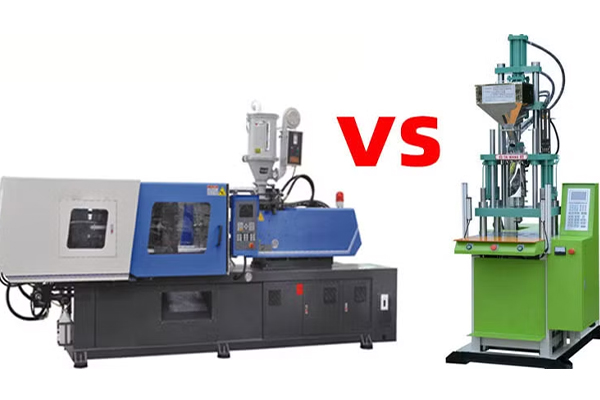Vertical vs Horizontal Injection Moulding for Plastic Parts
Horizontal injection moulding and vertical injection molding are two common plastic injection molding processes, each with their own unique advantages and applicability. There are significant differences between the two processes in the machine structure and operation methods during the injection molding process. Vertical injection molding is suitable for manufacturing vertical or vertical parts, while horizontal injection moulding is more suitable for manufacturing horizontal or horizontal parts.
These two injection molding methods have their own characteristics. Choosing the appropriate process should consider multiple factors such as product design, production needs, material flow and mold configuration. This article will compare horizontal injection moulding and vertical injection molding, and analyze their respective advantages and application scope.

The Horizontal Injection Moulding Process
Horizontal injection moulding has traditionally held a more prominent position in the realm of injection molding, although this does not imply inherent superiority. As we delve further into the topic, we’ll discover that each method possesses unique applications, advantages, and disadvantages.
In horizontal injection moulding, the mold operates along a horizontal axis when opening and closing. This configuration demands a consistent and precise injection pressure to adequately fill the mold cavities, ensuring proper packing and cooling. Horizontal molds are typically designed with more cavities than their vertical counterparts, resulting in the ability to produce a greater number of parts per cycle. Furthermore, due to the horizontal separation of the mold halves, parts are naturally released from the cavity upon ejection, eliminating the need for manual extraction.
Applicable Scope:
-
- Ideal for cylindrical components.
- Primarily suited for high-volume production runs.
- Advantageous for standard molding processes that do not necessitate inserts or overmolds.
Advantages:
-
- Efficient production of parts per cycle.
- A wider range of machine options available, including hydraulic and electric variants.
- Consistent cycle times and uninterrupted operation.
Disadvantages:
-
- Insert molding is notably more challenging and less efficient.
- Horizontal moulding machines occupy a larger footprint compared to their vertical counterparts.
The Vertical Injection Molding Process
Vertical injection molding distinguishes itself by the vertical movement of the two mold halves, operating in an up-and-down fashion to open and close. Typically, the injection mechanism is situated at the top of the mold. In this process, gravity plays a significant role in facilitating mold cavity filling, working in tandem with injection pressure to enhance both the speed and uniformity of filling.
Vertical injection molding equipment is thoughtfully designed with open clamps and rotary tables, enabling the simultaneous handling of multiple molds and operations such as pre-molding, injection molding, and post-molding procedures. Consequently, there is a reduced reliance on manual intervention, leading to heightened efficiency, increased productivity, and lowered operational costs.
A notable distinction between vertical and horizontal molds is that, in vertical molds, components do not automatically exit the mold after ejection, as is the case with their horizontal counterparts. Instead, in vertical molds, the components must be manually extracted by hand or with the assistance of robotic arms.
Applicable Scope:
-
- Simultaneous Operations: Vertical molds, thanks to their design and rotary tables, allow for the simultaneous use of two bottom halves and one top half. This setup permits pre- and post-molding operations to be conducted concurrently with resin injection, making it especially advantageous for tasks like insert molding or overmolding, where inserts or substrates need to be loaded before resin injection.
- Insert and Overmolding: Vertical molds excel in insert molding and overmolding, thanks to their mold configuration. Gravity naturally holds inserts in place, eliminating the need to incorporate elaborate mechanisms within the cavity to maintain positioning.
Advantages:
-
- Consistent material flow and even temperature distribution.
- Ideal for insert molding, particularly when compared to older or simpler horizontal moulding machines.
- Adaptable to manual operation and compatible with revolving tables for creating inlays and combination parts.
- Machine footprint is half the size of typical horizontal moulding machines.
- Lower pressure and clamping force requirements due to the influence of gravity in the process.
Disadvantages:
-
- Manual part removal can be more time-consuming.
- Risk of damage to parts during removal by robots or human operators.
- Precision is crucial in timing the manual removal step, posing challenges in maintaining consistent cycle times.
Excellent Injection Molding Expert–Sungplastic
Through our introduction, I believe you already understand the differences between horizontal injection moulding and vertical injection molding. They each have unique characteristics and are suitable for a variety of different application scenarios. Although horizontal injection moulding has always been the main choice in the injection molding field, this does not mean that other options do not exist. For example, for insert molding tasks, vertical injection molding is also a suitable option.
Sungplastic, as an experienced and well-equipped injection molding manufacturer, we have various types of injection molding machines, whether you need injection molding, insert molding or overmolding, we can meet your needs. We are your best partner from mold design to product production.
Get a free quote and design analysis today.
We’ll reply to you within 6 working hours.
We respect your privacy.
+86 139 2927 4777 (WhatsApp, Wechat)
